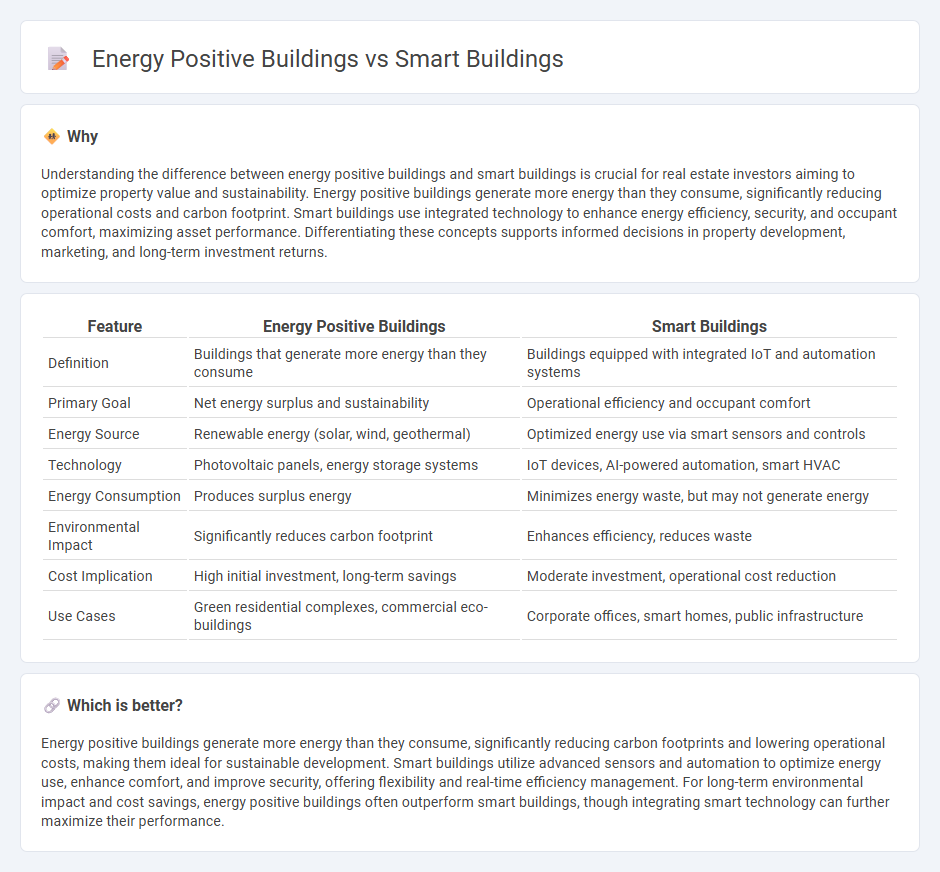
Energy positive buildings generate more energy than they consume through renewable sources like solar panels and advanced insulation techniques, significantly reducing carbon footprints and operational costs. Smart buildings integrate IoT technologies, sensors, and automation to optimize energy usage, enhance occupant comfort, and improve overall building management efficiency. Explore how energy positive and smart buildings are transforming real estate sustainability and innovation.
Why it is important
Understanding the difference between energy positive buildings and smart buildings is crucial for real estate investors aiming to optimize property value and sustainability. Energy positive buildings generate more energy than they consume, significantly reducing operational costs and carbon footprint. Smart buildings use integrated technology to enhance energy efficiency, security, and occupant comfort, maximizing asset performance. Differentiating these concepts supports informed decisions in property development, marketing, and long-term investment returns.
Comparison Table
| Feature | Energy Positive Buildings | Smart Buildings |
|---|---|---|
| Definition | Buildings that generate more energy than they consume | Buildings equipped with integrated IoT and automation systems |
| Primary Goal | Net energy surplus and sustainability | Operational efficiency and occupant comfort |
| Energy Source | Renewable energy (solar, wind, geothermal) | Optimized energy use via smart sensors and controls |
| Technology | Photovoltaic panels, energy storage systems | IoT devices, AI-powered automation, smart HVAC |
| Energy Consumption | Produces surplus energy | Minimizes energy waste, but may not generate energy |
| Environmental Impact | Significantly reduces carbon footprint | Enhances efficiency, reduces waste |
| Cost Implication | High initial investment, long-term savings | Moderate investment, operational cost reduction |
| Use Cases | Green residential complexes, commercial eco-buildings | Corporate offices, smart homes, public infrastructure |
Which is better?
Energy positive buildings generate more energy than they consume, significantly reducing carbon footprints and lowering operational costs, making them ideal for sustainable development. Smart buildings utilize advanced sensors and automation to optimize energy use, enhance comfort, and improve security, offering flexibility and real-time efficiency management. For long-term environmental impact and cost savings, energy positive buildings often outperform smart buildings, though integrating smart technology can further maximize their performance.
Connection
Energy positive buildings integrate advanced technologies to generate more energy than they consume, while smart buildings use IoT sensors and automation systems to optimize energy efficiency and building operations. The connection lies in smart buildings' capacity to monitor, manage, and optimize energy production and consumption dynamically, enabling energy positive buildings to achieve peak performance. This synergy enhances sustainability, reduces operational costs, and contributes to greener urban environments.
Key Terms
Building Automation Systems (BAS)
Building Automation Systems (BAS) play a crucial role in both smart buildings and energy positive buildings by optimizing energy use, indoor air quality, and occupant comfort through integrated controls for HVAC, lighting, and security. Smart buildings employ BAS to enhance operational efficiency and reduce energy consumption, while energy positive buildings leverage advanced BAS to not only minimize usage but also generate surplus energy through renewable sources integrated within the system. Explore the latest BAS technologies and strategies driving the evolution from smart to energy positive buildings.
Net Energy Production
Smart buildings integrate advanced technologies to optimize energy consumption, improve efficiency, and reduce operational costs, focusing primarily on energy management and occupant comfort. Energy positive buildings go a step further by generating more energy than they consume through renewable sources like solar panels and wind turbines, contributing excess energy back to the grid and achieving net energy production. Explore how these innovative structures redefine sustainability and energy independence.
IoT Integration
Smart buildings leverage IoT integration to enhance operational efficiency, occupant comfort, and energy management through real-time data monitoring and automated controls. Energy positive buildings go beyond energy efficiency by generating surplus energy using renewable sources, often relying on IoT systems for optimized energy production and consumption balancing. Explore the advancements in IoT-driven technologies transforming smart and energy positive buildings for sustainable urban development.
Source and External Links
Smart Buildings | Technology Trends and Innovations - Autodesk explains smart buildings as modern structures that use advanced technologies to connect, analyze, and optimize their performance for enhanced occupant comfort and efficiency.
What Is a Smart Building? - Cisco defines a smart building as one that converges various systems into a single IT managed network infrastructure, using technologies like Power over Ethernet for efficiency.
What is a Smart Building and How Does it Work - Enel X describes smart buildings as structures with interacting subsystems, controlled remotely to optimize energy consumption and enhance sustainability.
 dowidth.com
dowidth.com